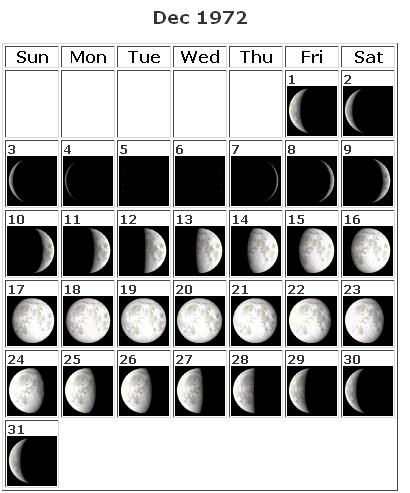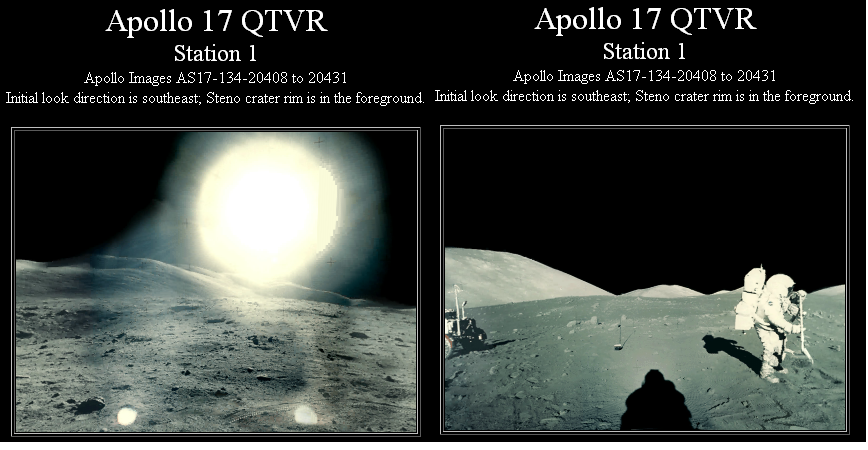In December of 1972, Apollo 17 astronauts Eugene Cernan and Harrison Schmitt spent about 75 hours on the Moon. Near the beginning of their third and final excursion across the lunar surface, Schmitt took this picture of Cernan flanked by an American flag and their lunar rover's umbrella-shaped high-gain antenna.
In December of 1972, Apollo 17 astronauts Eugene Cernan and Harrison Schmitt spent about 75 hours exploring the Moon's Taurus-Littrow valley while colleague Ronald Evans orbited overhead. Cernan and Schmitt were the last humans to walk or ride on the Moon - aided in their explorations by a Lunar Roving Vehicle. The skeletal-looking lunar rover was just over 10 feet long, 6 feet wide and easily carried astronauts, equipment, and rock samples in the Moon's low gravity (about 1/6 Earth's). In this picture, Cernan stands at the back of the rover which carried the two astronauts in lawn-chair style seats. An umbrella-shaped high gain antenna and TV camera are mounted in the front. Powered by four 1/4 horsepower electric motors, one for each wheel, this rover was driven a total of about 18 miles across the lunar surface. Its estimated top speed was a blazing 8 miles per hour. - nasa
The last time man walked on the moon was in 1972. Now NASA is planning to re-visit the moon by the year 2020 -- but a shocking discovery about Earth s companion may put a hold on those plans. Our moon looks calm and rather dull and nothing ever seems to change. Even an astronaut s footprint lasts millions of years; but now space scientists have learned something on the moon does change -- and it s quite shocking. "The surface of the moon can become electrified from charged particles in the surrounding space environment " says Timothy Stubbs Ph.D. a space scientist at the NASA Goddard Space Flight Center in Greenbelt Md. This electric event happens once a month when the moon passes through the earth s magnetotail. A magnetotail is caused when the highly-charged particles of the solar wind zoom past the earth and mix with earth s magnetic field creating a long tail that extends into the moon s orbit. "The moon is actually sitting in a sea of charged particles " Dr. Stubbs says. Each month the moon enters the magnetotail for six days. As it crosses inside the magnetotail the moon s surface becomes highly charged. If astronauts walked across the charged surface they might feel a static shock -- just like walking across a carpet and then touching a door knob. It s not a deadly shock but a powerful zap It s easy to know when the moon is passing through the earth s magnetotail -- just look for a full moon. No astronaut has ever landed on a charged-up full moon to know exactly what happens so learning more now will help astronauts in the future. "These sorts of things that affect astronauts are things that we d like to investigate before we return to the moon " Dr. Stubbs says. When NASA returns to the moon scientists plan to establish an outpost for long-term moon exploration -- and they plan to also explore the magnetotail.
via Preparing For A Walk On The Moon -- Astronomers Discover That The Earth's Magnetotail Charges The Surface Of The Moon.
"Apollo 17 - Taurus-Littrow - 20.10N 30.46W - Landed on December 19, 1972" according to this site. Oops! Typo?
The moon was full on December 19. The site must be wrong, otherwise Apollo would have to be a hoax. Ah, sure enough, Apollo 17 landed Dec 11 and returned the 15th.
The sun looks strange on the moon. This is from the Hawai‘i Institute of Geophysics and Planetology, the same site that gives us the Apollo 17 December 19, 1972 landing date.
A different site lists a slightly different landing location.
Taurus-Littrow 20.19080° N latitude, 30.77168° E longitude - si.edu
At 5:56 p.m. Thursday, Dec. 14, Challenger's ascent stage will lift Cernan and Schmitt off the moon to rejoin Ron Evans in the orbiting America. - time
This photograph was taken on December 13, 1972, by the Apollo 17 Commander, Astronaut Eugene A. Cernan.






1 comment:
None of the Apollo astronauts however report such occurrence in their short movies. I came across a chopped astronaut leg photo on the google moon that one looks better than " C Rock ".
http://goodastronomer.blogspot.com/
Post a Comment